
Hygrocybe is a genus of agarics in the family Hygrophoraceae. Called waxcaps in English, basidiocarps are often brightly coloured and have dry to waxy caps, white spores, and smooth, ringless stems. In Europe they are characteristic of old, unimproved grasslands which are a declining habitat, making many Hygrocybe species of conservation concern. Four of these waxcap-grassland species, Hygrocybe citrinovirens, H. punicea, H. spadicea, and H. splendidissima, are assessed as globally "vulnerable" on the IUCN Red List of Threatened Species. Elsewhere waxcaps are more typically found in woodlands. Most are ground-dwelling and all are believed to be biotrophs. Around 150 species are recognized worldwide. Fruit bodies of several Hygrocybe species are considered edible and are sometimes offered for sale in local markets.
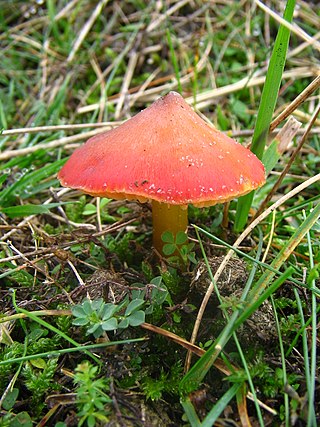
Hygrocybe conica is a species of agaric in the family Hygrophoraceae. In the UK it has been given the recommended English name of blackening waxcap, since all parts of the basidiocarp blacken with age. In North America it is commonly known as the witch's hat, conical wax cap or conical slimy cap. Hygrocybe conica is known to be a complex of at least eleven closely related species and as such is widespread in Europe, North America, Asia, and elsewhere.

Gliophorus psittacinus, commonly known as the parrot toadstool or parrot waxcap, is a colourful member of the genus Gliophorus, found across Northern Europe. It was formerly known as Hygrocybe psittacina, but a molecular phylogenetics study found it to belong in the genus Gliophorus. It had already been placed in Gliophorus, but it had been considered a synonym of Hygrocybe.

Hygrocybe punicea is a species of agaric in the family Hygrophoraceae. It has been given the recommended English name of crimson waxcap. The species has a European distribution, occurring mainly in agriculturally unimproved grassland. Threats to its habitat have resulted in the species being assessed as globally "vulnerable" on the IUCN Red List of Threatened Species. Records of H. punicea from North America, East Asia, and Australia require further research to see if they represent the same species.

Porpolomopsis lewelliniae, commonly known as the mauve splitting wax-cap, is a gilled fungus of the waxcap family found in wet forests of eastern Australia and New Zealand. The small mauve- or lilac-coloured mushrooms are fairly common and appear in moss or leaf litter on the forest floor in autumn, and are biotrophic. The key distinguishing feature is the splitting of the cap dividing down the middle of the individual gills.
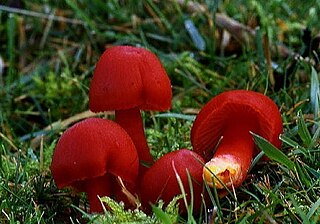
Hygrocybe coccinea, sometimes called the scarlet hood, scarlet waxcap or righteous red waxy cap, is a colourful member of the mushroom genusHygrocybe. These waxcaps are found across the Northern Hemisphere from China and Japan to Europe and North America. The small bright red mushroom is a familiar sight in unimproved grasslands in Europe in late summer and autumn, and woodlands in North America in winter.

Hygrocybe austropratensis is a gilled fungus of the waxcap family found in a few scattered locations in dry sclerophyll forests in eastern Australia. It is a small mushroom with a 1.4–3 cm diameter pale orange or orange-brown cap and buff-coloured stipe and gills. It is known only from near Sydney, Hazelbrook in the Blue Mountains, and Victoria.
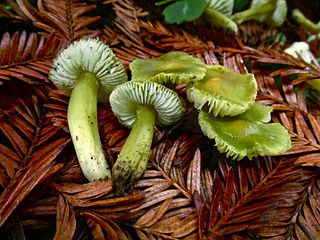
Hygrocybe virescens, commonly known as the lime-green waxy cap, is a species of agaric mushroom in the family Hygrophoraceae. The lime-green colored mushroom has a limited geographical distribution, having been reported only from California, Washington, and Mexico.

Hygrocybe chlorophana is a species of agaric in the family Hygrophoraceae. It has been given the recommended English name of golden waxcap in the UK. The species has a largely north temperate distribution, occurring in grassland in Europe and in woodland in North America and northern Asia; it has also been reported from mountainous areas of southern Australia. It typically produces basidiocarps in the autumn. In a few European countries, H. chlorophana is of conservation concern, appearing on national red lists of threatened fungi.

Lane Cove Bushland Park is located in suburban Lane Cove, 5 kilometres from the centre of Sydney, Australia. It is regarded as one of the more interesting areas of fungi in the country. In the year 2000, Bushland Park was placed on the Register of the National Estate, under the Australian Heritage Commission Act, 1975. Average annual rainfall is 1220 mm. Soils are moderately fertile, based on Hawkesbury sandstone and Ashfield Shale. The climate is warm and humid.

Cuphophyllus pratensis is a species of agaric in the family Hygrophoraceae. It has been given the recommended English name of meadow waxcap in the UK and in North America has variously been called the meadow waxy cap, salmon waxy cap, and butter meadowcap. The species has a widespread, mainly temperate distribution, occurring in grassland in Europe and in woodland elsewhere. The basidiocarps are edible and are occasionally collected and sold commercially.

Hygrocybe lanecovensis is an Australian mushroom of the waxcap genus Hygrocybe. An endangered species, it is found only at Lane Cove Bushland Park in suburban Sydney.

Humidicutis mavis is a gilled fungus of the waxcap family. It is found in Australia, Borneo, and New Zealand where the translucent white fungi grows from the ground to a height of 80 mm and a width of 50 mm.
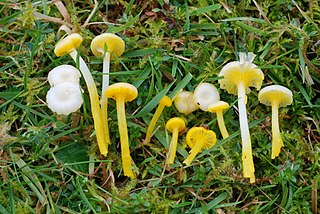
Gloioxanthomyces vitellinus is a species of agaric in the family Hygrophoraceae. It has been given the recommended English name of glistening waxcap. The species has a European distribution, occurring mainly in agriculturally unimproved grassland. Threats to its habitat have resulted in the glistening waxcap being assessed as globally "endangered" on the IUCN Red List of Threatened Species.
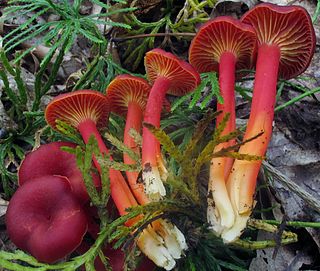
Hygrocybe appalachianensis, commonly known as the Appalachian waxy cap, is a gilled fungus of the waxcap family. It is found in the eastern United States, where it fruits singly, in groups, or clusters on the ground in deciduous and mixed forests. The species, described in 1963 from collections made in the Appalachian Mountains, was originally classified in the related genus Hygrophorus. It was transferred to Hygrocybe in 1998, in which it has been proposed as the type species of section Pseudofirmae.

Cortinarius kioloensis is a fungus native to Australia. It was described in 2009 by Alec Wood, and is related to the Northern Hemisphere species Cortinarius violaceus.

Neohygrocybe ingrata is a species of agaric in the family Hygrophoraceae. It has been given the recommended English name of dingy waxcap. The species has a European distribution, occurring mainly in agriculturally unimproved grassland. Threats to its habitat have resulted in the species being assessed as globally "vulnerable" on the IUCN Red List of Threatened Species.

Hygrocybe citrinovirens is a species of agaric in the family Hygrophoraceae. It has been given the recommended English name of Citrine Waxcap. The species has a European distribution, occurring mainly in agriculturally unimproved grassland. Threats to its habitat have resulted in the species being assessed as globally "vulnerable" on the IUCN Red List of Threatened Species.

Neohygrocybe ovina is a species of agaric in the family Hygrophoraceae. It has been given the recommended English name of blushing waxcap, since the lamellae (gills) and flesh turn pinkish red when bruised. The species has a European distribution, occurring mainly in agriculturally unimproved grassland. Threats to its habitat have resulted in the species being assessed as globally "vulnerable" on the IUCN Red List of Threatened Species.

Hygrocybe aurantiosplendens, commonly known as the orange waxcap, is a gilled fungus in the family Hygrophoraceae. It mainly occurs in Europe, but is also found in Siberia, and on both the East and West coasts of North America. It is uncertain if the continental ecotypes are in fact conspecific and are sometimes treated as distinct species.






















